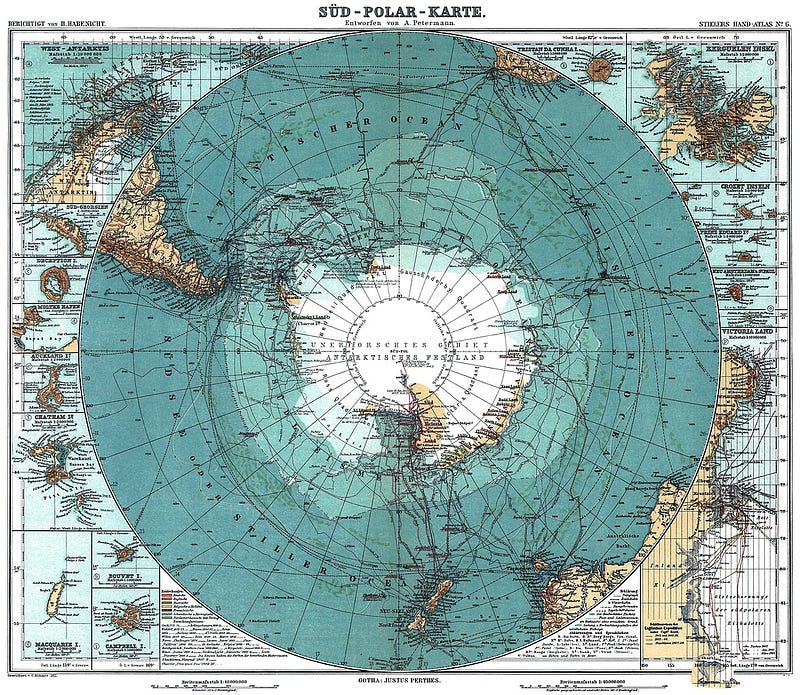The Antarctic Treaty: A Landmark Agreement for Peace and Science
Written on
Chapter 1: The Untouched Beauty of Antarctica
Antarctica today stands as a stunning and largely unspoiled landscape, characterized by vast glaciers, thriving bird colonies, and scattered scientific research facilities. Various nations are conducting crucial studies concerning ocean behaviors and climate change, yielding extraordinary insights about our planet. This is the Antarctica we recognize today, a treasure we often take for granted.

This breathtaking frozen expanse owes its preservation to a treaty signed on December 1, 1959, which effectively prevented Antarctica from becoming a battleground during the Cold War.
Section 1.1: The Background of Territorial Claims
As reported by the United States Department of State, the 1950s saw seven nations laying claim to various parts of Antarctica: Argentina, Australia, Chile, France, New Zealand, Norway, and the United Kingdom. Overlapping claims, particularly among Argentina, Chile, and the UK, sparked concerns about potential conflicts among these nations over their Antarctic territories.
The onset of the Cold War heightened anxieties surrounding these territorial disputes. Many leaders worried about the militarization of this remote area and the implications of overlapping military bases. Such a distant location posed challenges for traditional command and control, increasing the risk of an accidental confrontation between superpowers that could escalate into warfare.
Moreover, the remoteness of Antarctica was seen as an enticing venue for testing new nuclear weaponry. During the 1950s, escalating interest in Antarctica as a strategic military site and weapons testing ground fueled these fears. With the world under the looming threat of nuclear destruction and the vivid memories of modern warfare, there was little appetite to provoke tensions concerning the continent.
The concept for the Antarctic Treaty emerged from this precarious situation.
Subsection 1.1.1: The Formation of the Antarctic Treaty
To avert potential military conflicts in Antarctica, the treaty was signed on December 1, 1959. The foundational clause, Article I, states:
"Antarctica shall be used for peaceful purposes only. There shall be prohibited, inter alia, any measures of a military nature, such as the establishment of military bases and fortifications, the carrying out of military maneuvers, as well as the testing of any type of weapons."
This principle forms the essence of the treaty, designating a significant portion of the Earth as a militarization-free zone. Initially, twelve nations endorsed the treaty: Argentina, Australia, Belgium, the United Kingdom, Chile, France, Japan, New Zealand, Norway, South Africa, the United States, and the Soviet Union. These countries represented a significant segment of both NATO and the Warsaw Pact, alongside regional nations interested in the continent.
Further provisions of the treaty established guidelines for unrestricted scientific exploration and utilization of the continent for peaceful objectives.
Section 1.2: The Treaty’s Success and Ongoing Impact
The treaty proved to be remarkably effective, keeping military activities out of Antarctica and remaining in effect to the present day. Without it, the establishment of British, Soviet, and American military bases could have been a reality, potentially leading to nuclear tests that would have scarred Antarctica's pristine environment. Instead, the continent has been successfully safeguarded.
Chapter 2: A Legacy of Diplomacy
The Antarctic Treaty of 1959 is celebrated as a significant achievement in diplomacy, continuing to protect Antarctica and illustrating that arms reduction agreements can be negotiated, upheld, and respected in good faith.
The first video titled "Antarctic Treaty: The Power of Impossible Ambitions" delves into the treaty's historical context and its implications for global peace.
Additionally, a similar agreement, the Outer Space Treaty, was signed in 1967, affirming the demilitarized status of outer space.
The second video, "Australia and the Antarctic Treaty," explores Australia's role in the treaty and its significance for the continent.
Together, these treaties have ensured that the most remote regions accessible to humanity have remained free of military presence. This has curtailed an arms race during the Cold War that many feared would spiral out of control and lead to catastrophic consequences.
Today, we can appreciate documentaries showcasing large penguin colonies and the vibrant life of the Southern Ocean instead of witnessing the devastation wrought by military testing and occupation of Earth’s final frontier.